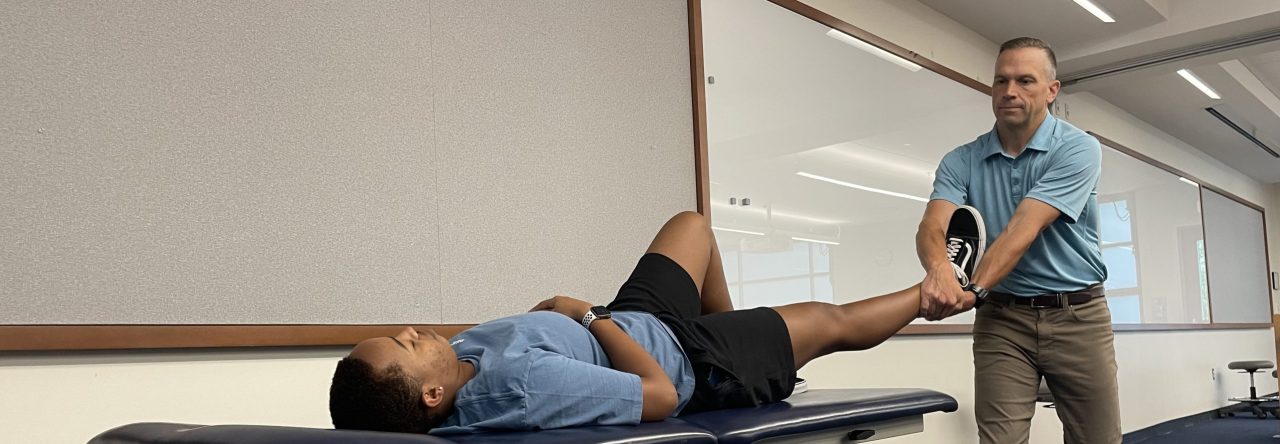Author Names
Walston, Z., Hernandez, L., Yake, D.
Reviewer Name
Kechao Tang, SPT
Reviewer Affiliation(s)
Duke University School of Medicine
Paper Abstract
Background and purpose: Conservative therapies for complex regional pain syndrome (CRPS) have traditionally focused on exercise and desensitization techniques targeted at the involved extremity. The primary purpose of this case series is to report on the potential benefit of utilizing manual therapy to the lumbar spine in conjunction with traditional conservative care when treating patients with lower extremity CRPS. Case description: Two patients with the diagnosis of lower extremity CRPS were treated with manual therapy to the lumbar spine in conjunction with education, exercise, desensitization, and soft tissue techniques for the extremity. Outcomes: Patient 1 received 13 sessions over 6 weeks resulting in a 34-point improvement in oswestry disability index (ODI) and 35-point improvement in lower extremity functional scale (LEFS). Patient 2 received 21 sessions over 12 weeks resulting in a 28-point improvement in ODI and a 41-point improvement in LEFS. Discussion: Both patients exhibited reductions in pain and clinically meaningful improvements in function. Manual therapies when applied to the lumbar spine in these patients as part of a comprehensive treatment plan resulted in improved spinal mobility, decreased pain, and reduction is distal referred symptoms. Although one cannot infer a cause and effect relationship from a case series, this report identifies meaningful clinical outcomes potentially associated with manual physical therapy to the lumbar spine for two patients with complex regional pain syndrome type 1.
NIH Risk of Bias Tool
Quality Assessment Tool for Case Series Studies
- Was the study question or objective clearly stated?
- Yes
- Was the study population clearly and fully described, including a case definition?
- Yes
- Were the cases consecutive?
- Cannot Determine, Not Recorded, Not Applicable
- Were the subjects comparable?
- No
- Was the intervention clearly described?
- Yes
- Were the outcome measures clearly defined, valid, reliable, and implemented consistently across all study participants?
- No
- Was the length of follow-up adequate?
- Cannot Determine, Not Recorded, Not Applicable
- Were the statistical methods well-described?
- Yes
- Were the results well-described?
- Yes
Key Finding #1
Mobilizations were utilized on patient #1, who saw improvements in pain, ODI, and LEFS that met MCID.
Key Finding #2
Both mobilizations and manipulations were utilized on patient #2, who also saw improvements in pain, ODI, and LEFS that met MCID.
Key Finding #3
Spinal manual therapy is an effective way for a therapist to elicit change in the perception of pain and sensation and alter motor recruitment.
Key Finding #4
Both mobilization and manipulation techniques have shown benefits in addressing central and peripheral nervous system components.
Please provide your summary of the paper
The study showed that mobilizations and manipulations of the lumbar spine can be effective for both alleviating pain and hypersensitivity in the region, as well as improving function. They looked at two drastically different subjects: a 52-year-old male with a bilateral total hip arthroscopy and a 33-year-old female with a bilateral bunionectomy. Subject 1, the 52 year old male, went through 13 PT visits over 6 weeks, undergoing soft tissue mobilization along lumbar paraspinals and gluteus medius and non-thrust mobilizations targeting the lumbar spine. Over the course of treatment he improved his lumbar spine active range of motion and no longer had any spinal mobility limitations affecting activities of daily living. Subject 2, the 33 year old female, received 23 treatments over 12 weeks and underwent both soft tissue mobilization as well as thrust manipulations. Roughly halfway through the treatment the patient reported significant improvements in her ability to ambulate and decreased pain. Both subjects also performed therapeutic exercises as part of their treatment, progressing from open chain to closed chain with increasing resistance.
Please provide your clinical interpretation of this paper. Include how this study may impact clinical practice and how the results can be implemented.
This is a study with a limited sample size, so it is difficult to draw any overarching conclusions. Still, it does show that manual therapy used in conjunction with exercises can be effective at both alleviating pain and helping restore physical function. However, given that no negative outcomes were reported, it is fair to say that manual therapy techniques are safe unless contraindicated. Whether a therapist decides to perform these techniques depends entirely on how skilled they feel they are. In case 1, the PT decided not to perform thrusts due to not having the confidence to perform them without aggravating symptoms.
